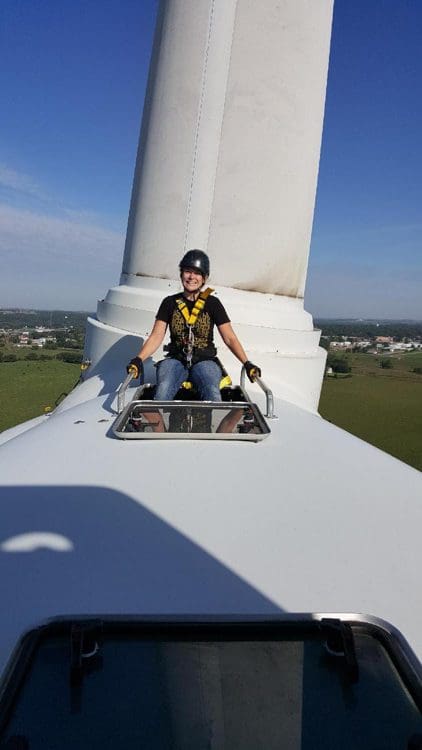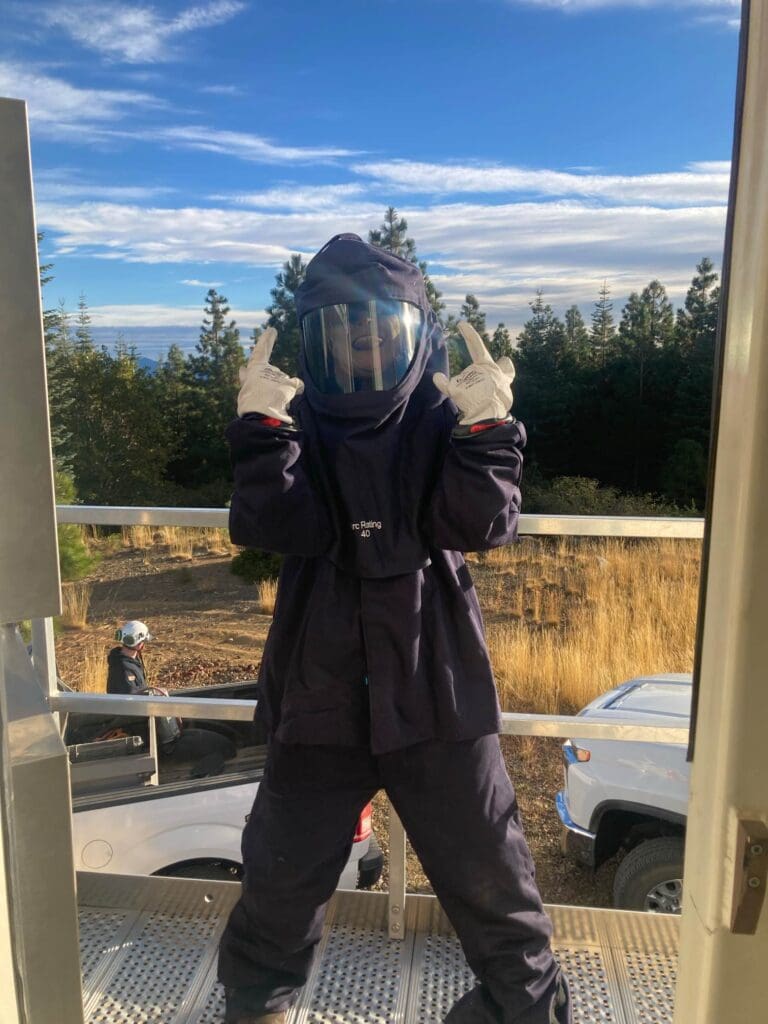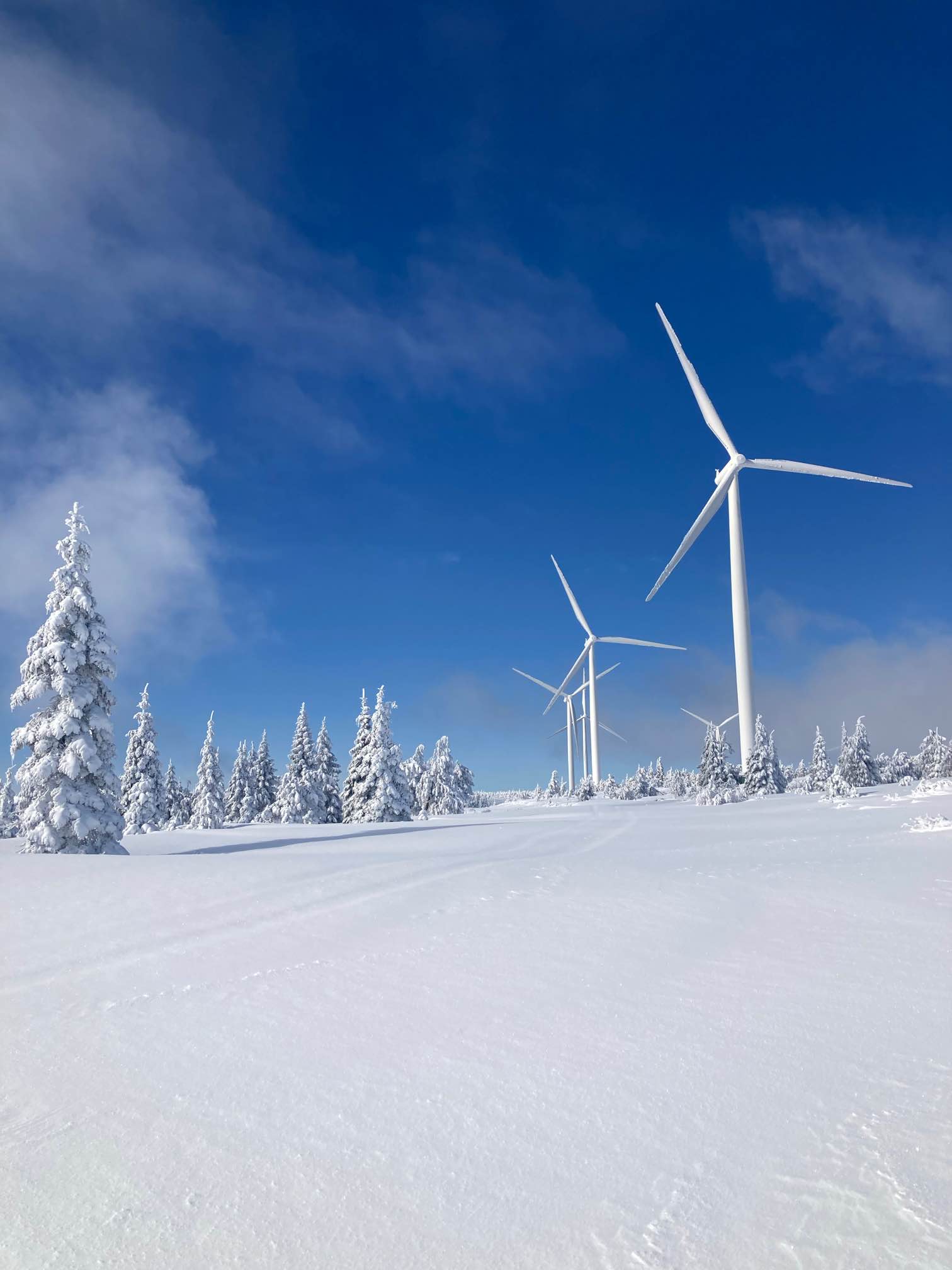Jessie Moffitt being a woman in wind energy
Woman Wind Turbine Technician for Fairwind in the United States
Jessie Moffitt studied Mathematics and then Wind Turbine Technology. As a wind turbine technician, she maintains and services wind turbines and is Global Wind Organisation GWO Advanced Rescue qualified.
Jessie works for Fairwind in the United States.
In this article she discusses her choice of career, experience, and being a woman in engineering.


Background
You studied mathematics at university? What attracted you to maths? Did you like numbers from childhood?
My father studied mathematics at grad school. When I was young, I remember sitting in the back seat of the car and he would give my sister and me puzzles to solve. I was always good at maths, but I really enjoyed solving puzzles.
Later when I went on to college, I started tutoring part time. That’s when it all made the most sense to me. If you know something well enough to explain it to another person so that they can then explain it to another; you really know your stuff.
Role models
Who were your inspirations or role models?
I’ve had many role models throughout the course of my life. My first and biggest being my mother. That’s because, she’s quite literally a superhero in that she has saved people’s lives in the ER (Emergency Room) working as a nurse. She inspired me more at home in other ways though. She has the most can-do attitude I have ever seen. Growing up we worked on all kinds of projects together. We even built a house together with another role model of mine. I was lucky enough to have Janice Lawrence, a woman Union Carpenter living next door. She’s remained a family friend even after she moved away.
I couldn’t possibly name all of my role models or the people I’ve looked up to on one page. Or convey my gratitude and explain how they have had a hand in shaping my life.
“It takes a village.”


Mathematics to Woman Wind Turbine Technician
You then studied wind turbine technology which is different. What caused you to make this change? How has your maths helped you?
Studying mathematics comes in handy for many, many things. The reason I really liked maths is also the reason I love being a Wind Turbine Technician. I love solving puzzles. The questions one asks oneself in mathematics are the same we ask ourselves when troubleshooting.
First – What am I looking at?
Second – What am I trying to find?
Third – What resources can I use to help me solve this?
Inspiration for becoming a Woman Wind Turbine Technician
Was there a particular person who inspired you to consider wind turbine technology?
My mother is going to love this as I have to give her all of my credit.
I had just finished my BS in Mathematics from Purdue University and I was trying to get a job, like anywhere!! I had taken a few graduate classes and thought about getting my master’s degree, but university is expensive, and I didn’t know how I was going to afford it. As well, I didn’t even really know what I wanted to do. I saw my colleagues going into finance and actuarial sciences and I thought I would just be bored to tears doing any of that. I was in this place in my life where I really had no idea what I wanted to do, and I didn’t want to get stuck in a job I hated.
One day my mother came home and said:
“Jessie, I know what you should do.”
She used to listen to NPR (National Public Radio) on her way to work every day and that day they had an interview with Dan Lutat, Executive Director of Wind Turbine & Technology from Iowa Lakes Community College.
Studying Wind Turbine Technology
So, I listened to the interview, and it got me excited. I had no idea this career path even existed. I started looking up videos and reading articles and got more and more excited about it. A month later I met Dan, and he showed me around the college and told me about the course. I enrolled and started the following semester.


Typical day as a Woman Wind Turbine Technician
What’s your typical day like?
Every site is a little different but mostly all have a similar set up in their daily routine. We start with a safety meeting, sometimes physical stretches, a routine I quite like. Next we go over the plan of the day, who will be where and doing what. We gather tools, fill out our PTP (Pre-task plan)/JSA (Job safety analysis) and then head out to the towers to work.
How much of your time is spent ‘hands on’ and how much on admin or other tasks?
Most of my job is hands on. I love being a technician and being out in the field. There’s always paperwork to fill out but the best part of the job is working on the tower.
What size teams do you work in?
I am always in a team of at least 2. Depending on the size of the site there may be many technicians or not many at all. The smallest team I’ve had at a site was 3 and we did everything.
Challenges working in wind turbine technology
What do you find most challenging when you are working?
There are many challenges all technicians face. I would say from my experience there are more for women. Ill-fitting PPE for women has become a more talked about topic. When I started, I was wearing all men’s clothes. Finding boots was a nightmare! Although we are starting to see some change now and more options for women, companies still have a long way to go in my opinion. I would love to see a women’s workwear section that is just as big as the men’s.
Have you ever arrived and found that it’s been much easier than you expected? For example, have you just needed to switch something on?
This is my favourite type of fix! We joke around saying:
“Did you try turning it off and then back on again?”
Physical fitness as a Woman Wind Turbine Technician
How important is physical fitness at work for you?
There are weight restrictions for technicians due to the harness you wear and the ladder that supports you. Aside from that a technician needs to be able to lift some heavy objects. Most job descriptions say 35-50 pounds and/or 100 on occasion.
In my opinion you would want to be able to drag your partner to safety in an emergency if you did not have rescue equipment readily available. I would say physical fitness is important for all humans but in wind, it may come in even more handy.


Safety clothing for a woman wind turbine technician
What sort of safety clothing, footwear and harnesses do you need to wear?
On a normal day a technician will need to wear:
a CAT2 FR (Fire Resistant) shirt and trousers,
steel toe or composite boots,
a hardhat,
safety glasses,
gloves,
a full body harness,
shock absorbing lanyards,
a glide lock or cable grab,
and work positioning lanyards.
Some technicians also wear SRKs (Self Rescue Kits) on their harnesses. Depending on the work a technician might also need electrical gloves and leather protectors, a face shield, and possibly even a CAT4 suit.
Are there challenges finding things which fit well and are comfortable?
YES! Depending on the company you work for you might have a limited selection. In addition, women cannot wear any bra with underwire. The few FR (Flame Retardant) bras on the market are extremely expensive and none have pads in them. When it comes to boots, good luck finding them in stores! If they even have a women’s section, it will always pale in comparison to the options for men. Trousers are another issue but we’re starting to see more options for women. In my experience it is all trial and error. I’m always trying new products.


Working in the cold
How do you personally cope with the cold?
In the winter you have to “bundle up”. I wear leggings underneath my trousers and if it’s extremely cold or I’ll be out there for a long time I might wear overalls. I’ll also wear long sleeves, a sweatshirt, and a coat, winter gloves, a balaclava, and a winter hat. Also, I’ll pack a heater to bring up tower and hand warmers. I also wear warmers on the top of my socks. I’ve found that Muck boots are best for deep snow and while they don’t yet have women’s composite toe, they do offer them in smaller sizes (men’s 5).
Working in heat
What about working in heat, what is your advice for that?
In the summer it can be miserable wearing all of your PPE. The most important thing to do is to keep hydrated. I normally drink a lot of water (40-60oz) right before bed and keep hydrated throughout the day. I also bring up a cooler of ice & water. If I start to get overheated, I will soak a towel in the cooler and wear it around my neck. I encourage my team to stay in the shade as much as possible and wear sunscreen.
Women turbine technicians
What clothing and footwear advice would you give to other women turbine technicians?
Do not rely on men to tell you what to wear. If you know a woman you can ask, go to her. Also, some men’s trousers are going to be better than women’s trousers. I love trousers with built-in knee pads. If you live somewhere with all the seasons, make sure you have work clothes for all those seasons. Work wear is also like personal wear. What fits one person really well may not fit another well at all. After being in this field for several years I’m still trying new boots and clothes. If you find something you like and it works for you, stick to it! However, you can always test drive something new.
Advance and blade rescue in wind turbine technology
You are qualified to perform intricate rescues. Can you explain what this involves?
On my side of the industry, you have to renew your GWOs (Global Wind Organization certifications) every other year. Advanced Rescue and Blade Rescue are more intricate than rescuing a person on the ladder or in the basement.
Can you give examples of rescues?
There are a few confined spaces in the tower. The hubs for example can be very small and hard to move around in. You might need to figure out how you are going to move a body through a tight space. In addition, you will learn how to use special rescue equipment such as a spine board and spec pack (for patient extraction). You may also need to put a harness on an unconscious person so it will be useful to know body mechanics and how to move them.
For example, if a person is lying on their back, you can lift the opposite knee and pull the opposite arm straight across their chest. From there you can grab their hip and pull them toward you. This will allow you to turn the body much easier than simply trying to roll their body onto their side.
Women in Engineering
You are working in a male dominated industry. How do you find this? How do you think it will change over the next ten years?
I hope to see more change over the next ten years. Ideally, I would love to see an equal number of women in the field as men. We are certainly starting to see more women in the field.
What needs to be done to encourage more women to consider this career?
Women need to have the same options and opportunities as men in this field. It would be ideal to see the leading companies developing workwear and PPE and to take a forward-thinking stance and the initiative to develop and test women’s lines.
Women also need sponsors. We need people already in the industry to stand up and say we belong here. And the harassment has to stop! Any person is not going to stay with something if they feel they don’t belong.
What would you say to a woman who is considering working in the wind power industry?
I could go on for days with this one! It is a great field despite its challenges. You will learn a lot and you will grow. As well, you will do things you didn’t think you were capable of. You will make a difference.
Seek out support. There are groups out there for supporting women in trades:
WRISE (Women of Renewable Industries and Sustainable Energy)
Bold as Brass for trades and male dominated industries.
I’ve started my own private group called Women in Wind.
Build your team and support each other.
I would also add that there are a lot of avenues you can take in the wind industry. And you will learn a lot of transferable skills.
New Wind Turbine Technicians
What sort of personality traits and skills are ideal to be a wind turbine technician?
I would highly suggest taking some training or going to college before taking a job in wind. But a willingness to learn will take you far.
Apart from a strong technical background, what are the three most important skills to have?
An inquisitive mind will help anyone in this field. If you like to know how things work this will be useful for you.
Being able to work within a team is also important. You can’t do this job all by yourself.
Always be willing to learn.
What are the key things to do in your first month as a wind turbine technician?
Learn everything you can and keep learning. Get familiar with the tower. So, in an emergency what would you do? Where would you go? Also, be helpful. If you see another team working on something, ask if they need a hand.
What are the key things to do in your first year as a wind turbine technician?
Make sure you aren’t doing the same thing every day/week/month. Always be trying your hand at something new while perfecting what you have learned so far.
Conclusion to working as a woman wind turbine technician
When I was trying to find a career path to follow, I had a few requirements for the job. I didn’t want to be miserable. I wanted to feel like the work I did would make a difference. And if I could do something that would help the planet that would be a bonus. The wind industry fulfilled all those requirements.
Since I’ve started in wind, I have learned so much. I’ve become stronger, I’ve become a better leader, and I feel fulfilled by my work. I love fixing things and the sense of accomplishment that comes with that. I’ve met people who will be friends for life. I’ve taught people skills that they will carry with them for the rest of their lives.
Deciding to be a part of this industry has been the best decision I have ever made for myself. I’m proud to be a wind tech.


Further Reading about wind turbine technology
Michael Martin – Wind Turbine Technician and Technical Writer
Begum Demirtas is the first woman to join the wind turbine support team at Vestas, Skane, Sweden. She shares her story
Gökhan Oruç on becoming a Wind Turbine Technician


Responses